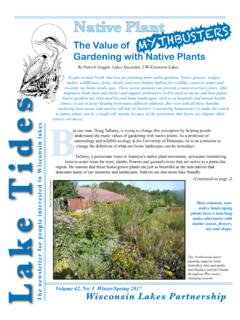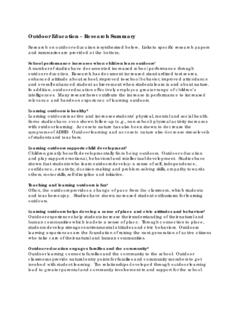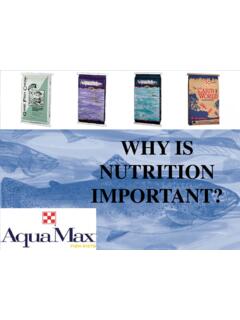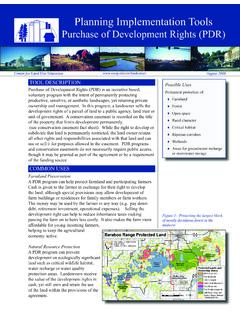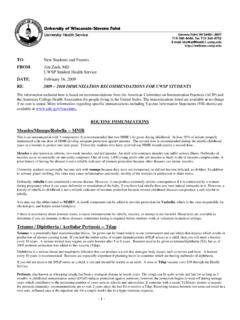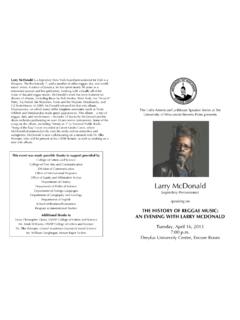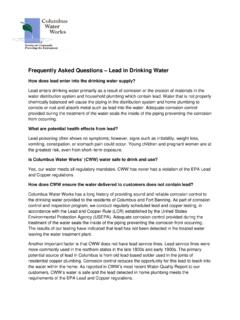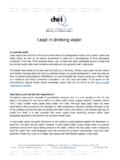Transcription of Lead in Drinking Water - UWSP
1 What is Lead?How can I be exposed? PRINTED ON RECYCLEDPAPERW isconsin Department of Natural ResourcesBureau of Drinking Water & GroundwaterLeadinDrinkingWaterThis brochure tells of growing evidencethat even moderate levels of lead can beharmful to human health, and particu-larly to the health of small children anddeveloping fetuses. For this reason,Wisconsin residents are advised to:1) run your Water in the morning for two orthree minutes, or until it gets as cold as itwill get, before you drink it, or2)find out how much lead your Water isdissolving from your plumbing your Water comes from a communitywater system or your own private well, thisbrochure will discuss the lead issue in somedetail, and will provide some specificrecommendations for a variety of Wisconsin Department of Natural Resources Bureauof Drinking Water & Groundwater would like to thankthe Groundwater Coordinating Council (GCC) EducationSub-Committee for their part in the development andediting of this publication.
2 For more information on theGCC, it s member organizations and programming,please visit Choose Government, State Agencies, followed by List of Agencies thenselect Groundwater Coordinating Council. Lead is a toxic metal which has been usedin the construction of most householdplumbing systems in Wisconsin. Waterwithin the plumbing system will continu-ously dissolve the lead it contacts. Therate can vary greatly with variations innatural Water quality and the age of theplumbing system. Most Water in Wiscon-sin is corrosive enough to dissolve someamount of lead. When the Water standsfor extended periods of time, such asovernight, lead concentrations in thewater can increase is widespread in the environment,and people absorb lead from a variety ofsources every day.
3 Although lead has beenused in numerous consumer products, themost important sources of lead exposureto the general population are:Lead-based paintFood (which can be contaminated bylead in the air or in food containers,particularly lead-soldered foodcontainers)Soil and dust (which has beencontaminated by air, and includes dustboth inside and outside the home)Outside air from vehicle emissions andother sources. These have beenreduced significantly since placingfederal controls on lead in gasolineDrinking Water (from the corrosion ofplumbing systems)It is estimated that lead in Drinking watercontributes between 10 and 20% of totallead exposure in young children.
4 Food isthe greatest single source of lead for theaverage does lead get into mywater supply?Most Wisconsin Drinking watersources, either wells or lakewater intakes, have little or nomeasurable lead. The source oflead in Drinking Water is mostlikely lead pipe or solder in thehouse Water supply plumbing,or lead service lines which joinbuildings to street typical circumstances, lead will dissolve intothe Water . The concentration of lead in drinkingwater can vary greatly, depending on the corrosivityof the Water , the type and age of the plumbingmaterials used in the house, and the length of timethat the Water stands in the pipes.
5 The highest levelsof lead occur when very corrosive Water standsmotionless in lead or lead-soldered copper pipe forlong periods of varies greatly with Water quality, but hardwater is generally less corrosive than soft , hard Water alone does not alwaysguarantee that there will be no elevated lead greenish discoloration and unpleasant taste of tapwater are indications that copper pipes arecorroding, but significant corrosion can occur even ifthere are no visible age of a house relates to the type of plumbingsystem that can be expected. Through the early1900s, lead pipes were commonly used for interiorplumbing in some areas.
6 Until the 1940s, lead pipingwas often used for the service lines that joinbuildings to street Water mains. Lead piping can berecognized as a dull-grey metal which is soft enoughto be easily scratched with a key or lead will be shiny the 1930s, copper pipesor galvanized steel pipesreplaced lead pipes inmost residentialplumbing. However, theuse of 50/50 tin/leadsolder and lead-containing fluxes to joincopper piping continuedin Wisconsin until a banon the use of lead solderand fluxes becameeffective in1984. Homes constructed after that dateshould have lead-free Water supply plumbingsystems. Also, any repairs of existing plumbingsystems must be made with lead-free materials,such as tin/antimony (95/5) indicate that the levels of dissolved metals indrinking Water will decrease as a building ages.
7 Thisis because, as time passes, a mineral or oxidationcoating forms on the inside of the pipes (if the wateris not too corrosive). This coating can partiallyinsulate the Water from the lead materials,significantly reducing levels of dissolved longer Water stands in a pipe the more lead canbe dissolved. Because lead will continuouslydissolve into the Water , the resulting leadconcentrations will increase directly with time. Thisis why Water which is drawn first thing in themorning, or after any extended period of nonuse, willcontain the highest levels of and state standards have established anaction level of 15 parts per billion (ppb) for lead indrinking Water .
8 The standard is adjusted to accountfor average lead exposures from other environmentalsources as well. Nevertheless, lead has no beneficialhealth effects, and it is advisable to reduce the leadin your tap Water as much as possible. This isparticularly true for pregnant women or youngchildren who may drink the Department of Natural Resources provides equalopportunity in its employment, programs, services andfunctions under an Affirmative Action Plan. If you haveany questions, please write to Equal Opportunity Office,Department of the Interior, Washington DC brochure is available in alternate format uponrequest. Please call 608 2003LP 5/03 Where can I get more information?
9 The DNR has five regional offices statewide toserve you. Talk to your Drinking Water &groundwater specialist at one of the DNR regionaloffices or visit the DNR web site at Choose Drinking Water &Groundwater from the drop-down menu, andselect from a variety of listed Region1125 N. Military AvenueP. O . B ox 10448 Green Bay, WI 54307-0448(920) 492-5800 Central Office101 S. Box 7921 Madison, WI 53707-7921(608) 266-0821 DOUGLASBAYFIELDASHLANDIRONBURNETTVILASWA SHBURNSAWYERPRICEONEIDAFORESTFLORENCEBAR RONPOLKRUSKTAYLORCHIPPEWADUNNST. CROIXPIERCEPEPINEAU CLAIRECLARKLINCOLNMARATHONLANGLADEMARINE TTEOCONTOMENOMINEESHAWANODOORKEWAUNEEBRO WNOUTAGAMIEWAUPACAWOODPORTAGEMANITOWOCWI NNEBAGOCALUMETWAUSHARAJACKSONJUNEAUADAMS MARQUETTEGREENLAKEFOND DU LACSHEBOYGANMONROESAUKCOLUMBIADODGEWASHI NG-TONOZAUKEEMILWAUKEEWAUKESHAJEFFERSOND ANEKENOSHARACINEWALWORTHROCKGREENLAFAYET TEIOWAGRANTRICHLANDCRAWFORDVERNONLA CROSSEBUFFALOTREMPEALEAUNORTHEASTWEST CENTRALSOUTH CENTRALSOUTHEASTNORTHERNS poonerRhinelanderMadisonGreenBayMilwauke eEau ClaireREV 7/02 Regional BoundariesRegion OfficesState of Wisconsin Department of Natural ResourcesWhat is the State of Wisconsin doingabout
10 The problem of lead indrinking Water ?DNR rules establisha lead action level of 15 ug/L(micrograms perliter) in publicwater community andnon-transient non-community watersystem owners arerequired under DNRrules to regularly testhigh-risk locations for more than ten percent ofthe locations exceed the action level the systemowner must conduct a public education programand install system-wide treatment to well and facility construction rules currentlyprohibit the use of lead in wells, pumps, andother Water system of Commerce rules currentlyrestricts the use of lead in solder, fluxes andplumbing system will continue to work with community watersystems to reduce the corrosivity of the waterthrough central treatment.
